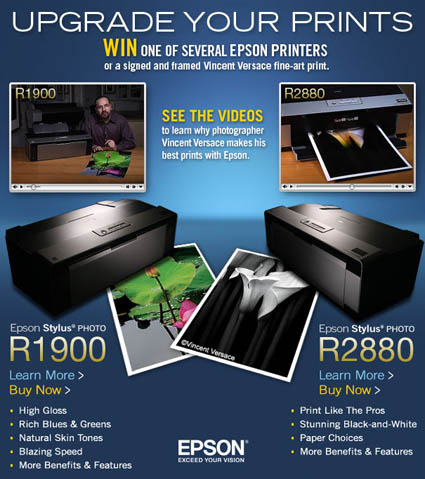16 Bit Printing

16 bit printing is finally possible. It wasn’t before? That’s right.
Only Photoshop CS4 / Lightroom 2 actually deliver all 16 bits to the printer.
Only OSX 10.5 allows this; not Windows yet.
And only the latest updated drivers.
What improvements can you expect to see? Smoother gradations. Slightly more precise edge rendition. As printer dot structures get finer and more precise, expect to see more improvements. Higher quality digital capture (higher bit, lower noise, greater resolution) will also improve output.
Find CS4 and Lightroom here.
Find Epson drivers here.
Learn more in my Fine Digital Print workshops.
Epson Print Academy – Wilhelm / Reichmann
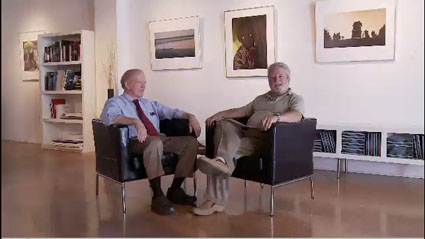
The videos for the Epson Print Academy are always rich. In the newly updated Track 2 sessions attendees get to see a 14 minute short cut of Michael Reichmann (Luminous Landscape) interviewing Henry Wilhelm (Care and Permanence of Photographs) on longevity. A lot of myths and misnomers are dispelled. It’s well worth scanning.
You can see and/or listen to the full 68 minute version here.
Find out about the next Epson Print Academy near you here.
Epson Print Academy – Giveaways


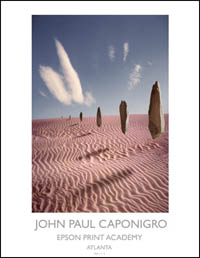
There are a lot of surprise giveaways during the Epson Print Academy – books, DVDs, software, posters, prints, etc. I give away posters made onsite, often during the presentation.
Find out about the next Epson Print Academy near you here.
Epson Print Academy – Downloads
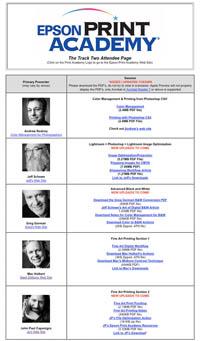
The Epson Print Academy Track 2 downloads contain dozens of PDFs, test files, and actions. They’re electronic. So they’re green. They’re portable. They’re transmittable. And they’re updateable. They evolve and grow as the sessions do. Items include Color Management (Rodney), Sharpening Workflow (Schewe), B&W Conversion (Gorman), Fine Art Workflow (Holbert), The Art of Proofing (Caponigro) and much, much more.
They’re for attendees only!
Find out about the next Epson Print Academy near you here.
Check out my downloads here.
Check out my Fine Digital Print workshops here.
Epson Print Academy – Atlanta 11/8

The Epson Print Academy will be in Atlanta tomorrow Saturday, November 8th at the Renaissance Atlanta Hotel Downtown. It’s the first of a 15 city tour. Track 1 & 2 are both updated with new sessions. Track 1 is hosted by Jack Reznicki with live demonstrations and informative videos featuring industry professionals giving an excellent introduction to the medium. Track 2 features advanced sessions by Andrew Rodney, Jeff Schewe, Greg Gorman, Mac Holbert and John Paul Caponigro. The gallery features images printed with the new Epson Stylus® Pro 7900 printers with UltraChrome® HDR inks. Attendees will be registered to win one 4880 printer (given at each venue) and one of the 7900 printer (given July 2009). At $79.95 and $149.95, these sessions are a phenomenal value. Don’t miss them!
Get more information here.
Find out about the next Epson Print Academy near you here.
Check out my Fine Digital Print workshops here.
Creativity – Commenting On Images

How many times have you been frustrated by the feedback you get and give?
Often it’s too simple.
“I like it.”
“I don’t like it.”
But you want more.
If you knew more you could improve more.
So, go further!
Whenever you’re looking at images ask yourself for more with one simple word. “Why?”
You many be surprised how hard it is to put your thoughts and feelings into words.
Don’t quit.
Try anyway.
You’ll find out some really interesting things.
Later, start asking others, “Why?”
You’ll get some really interesting answers.
Check out 12 books I recommend on critical thinking in photography here.
Get feedback in my workshops.
New Desktop Calendar
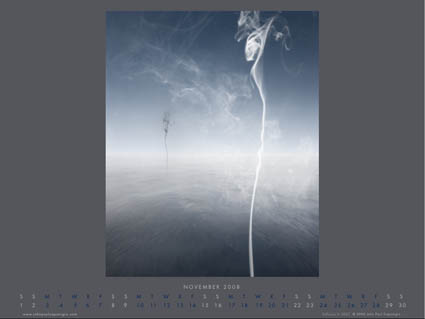
This month’s desktop calendar features an image from my series Suffusion.
It’s free!
Download it here.
Get the free PDF portable gallery of my Suffusion series here.
Vote!

It’s election day in the USA.
Make your voice heard!
Vote!
If you have a firm opinion vote your conscience. If you’re undecided vote your gut reaction. If you don’t like the candidates, vote for the independents or write in a vote of no confidence. If you’re don’t feel voting will make a difference, I assure you it does. Men and women have died for the freedoms we enjoy. Men and women are still dying while trying to get the freedoms we enjoy. A healthy democracy (government for the people by the people) requires participation. Many people are hoping for record turnouts this year.
Be a part of history. Vote!
PS Even if you haven’t registered, in many places it’s not to late; some places allow registration at the time and place of voting if you present a valid form of ID and a document stating residency (tax bill, rental agreement, paycheck, etc).
Dan Steinhardt – About Paper / Meaningless Terms
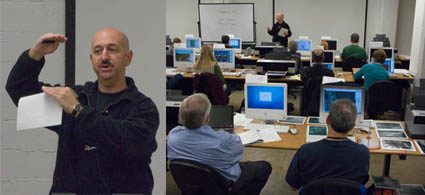
Last week at The Fine Art of Digital Printing workshop The Fine Art of Digital Printing workshop (taking place at Brooks sponsored by Epson) spoke about paper. We always have special guests at these events and we were delighted that Dano was able to come this time. Dano explained a lot of interesting things about paper (three types – swellable, microporous, cotton fiber)(the history and myths of OBA’s – optical brightening agents – used in paper coatings, some longer lasting than others)(longevity facts – it’s a combination of many factors, lightfastness being only one).
One of the funnier things that everyone came away with was how many terms we’re used to hearing and using that are essentially meaningless and can be potentially misleading if you make assumptions often associated with the terms. “Fine art paper”, “museum grade”, “archival”, “pearl”, “luster”, “stipple” are all marketing terms with no definite meaning. “Permanent” means water fast, but doesn’t imply light fast. “Compatibility” simply means the paper will transport through the printer – nothing more. So it pays to know which terms are truly meaningful/useful and which terms aren’t.
More to come on this. Stay tuned.
Look for upcoming Epson Print Academy dates here.
Check out The Fine Art of Digital Printing workshops here.
Check out my Fine Digital Print workshops here.


